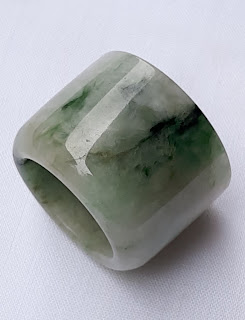清朝老坑冰種三彩白底青飄藍花帶點紫翡翠雕武扳指
Qing Dynasty old mine ice type tricolor white ground green and blue with some violette colors jadeite carved military archery thumb ring
https://youtu.be/WwRDbM58s3Y?si=wjemmkb9GhLUpFBQ
https://youtu.be/IPuRUMVC3Gk?si=vB2cZAocYk0XkN0o
https://youtu.be/A7oW_4t5gYQ?si=JzdTH7Qc_W7uYi59
重量: 37 公克
比重: 3.3 (翡翠比重)
尺寸: 高 2.5 x 內圈直徑 2.2 x 外圈直徑 3.3 x 厚 0.55 厘米 cm
Weight: 37 grams
Specific gravity density: 3.3 (The specific gravity density of jadeite)
Dimensions: Height 2.5 x Inner ring diameter 2.2 x Outer ring diameter 3.3 x Thickness 0.55 cm
此翡翠扳指有射箭使用過的痕跡,係來源所有人陳俊英女士 ( 1932 - ) 的父親陳萬承是明朝洪武十八年 (公元 1385 年) 被明朝皇帝朱元璋封為軍事大元帥的先祖陳秀甫的第 20 代後裔。而陳秀甫的第 18 代後裔陳雲標(日據台灣時户籍造為陳云發)係清朝來台人士考入「清朝武秀才」第一人,清朝學名稱「登雲」,設「登雲館」傳授百般武藝予有志青年,一時顯名遐邇。此翡翠扳指即為其從清朝旗人貴族處所取得並帶入台灣使用。而在日本佔據台灣之前,陳雲標的宗侄陳東福即已經考進清朝武秀才。
清朝的扳指在統治階層非常流行,分為文扳指和武扳指,文扳指是文臣佩戴,講究材質珍貴、工藝複雜和外觀美麗,武扳指則是武臣佩戴,在工藝和外觀上並不講究,通常素面無紋,而此翡翠扳指素面無紋且有射箭使用過的痕跡,是個武扳指。
清代各種規制日趨完善,扳指雖小卻也是森嚴等級的一種象徵,多以玉石、翡翠、瑪瑙、珊瑚等名貴材料製作的扳指,非皇室貴冑一般人是不敢也不能隨意佩戴的。普通旗人佩戴的扳指,以白玉磨製者為最多,貴族扳指則以翡翠質料者為上選。陳雲標並非旗人貴族,卻將此翡翠扳指帶入日據台灣使用,顯然清朝政府也是鞭長莫及,毫無管轄權利。
清朝諸位帝王對翡翠扳指喜愛有加,因而盛極一時,達官貴人喜歡將之戴在手指摩挲,流露出地位、權利、富貴和氣質,遂成為身分地位的表徵。紀曉嵐在《閱微草堂筆記》中記載,翡翠因其美麗稀有,在乾隆朝早期到中晚期短短五、六十年間,即從鮮為人知的玉材一躍而上,價值超過和闐美玉,成為「玉石之王」。
This jadeite carved archery thumb ring has traces of being used in archery and is attributed to the owner, Ms. Chen Junying (1932-), whose father, Chen Wancheng, was the 20th generation descendant of ancestor Chen Xiufu. Chen Xiufu was nominated as military generalissimo by Emperor Zhu Yuanzhang of the Ming Dynasty in the 18th year of Hongwu period in the Ming Dynasty (AD 1385). The 18th generation descendant of Chen Xiufu was Chen Yunbiao (whose registered household registration name was Chen Yunfa during the Japanese occupation of Taiwan). Chen Yunbiao was the first person entering into Taiwan from the Qing Dynasty to pass the national-exam as a "Qing Dynasty Martial Arts Scholar". His Qing Dynasty's scholar name was "Dengyun" and the "Dengyun Martial Arts Pavilion" was established by him. He taught all kinds of martial arts to aspiring young people, and became famous for a while. This jadeite carved archery thumb ring was obtained by him from the nobles of the Qing Dynasty bannermen and brought to Taiwan for him to use. Before Japan occupied Taiwan, Chen Yunbiao's nephew Chen Dongfu had already passed the national-exam in the Qing Dynasty as a martial arts scholar.
The Qing Dynasty's archery thumb ring was very popular among the ruling class people. It was divided into civil archery thumb ring and military archery thumb ring. Civil archery thumb ring was worn by civil servants and paid attention to precious materials, complex craftsmanship and beautiful appearance. Military archery thumb ring was worn by military officials and was not particular about craftsmanship and appearance. The surface of military archery thumb ring is usually plain and has no patterns. This jadeite carved archery thumb ring is plain and has no patterns on the surface and has traces of being used in archery. It is a military archery thumb ring.
In the Qing Dynasty, various regulations were gradually perfect. Although the archery thumb ring was small, it was also a symbol of strict hierarchy. Archery thumb rings were mostly made of jade, jadeite, agate, coral and other precious materials. Most people who were not members of the royal family and nobles did not dare and could not wear them casually. The archery thumb rings worn by ordinary bannermen are mostly made of white jade, while the archery thumb rings worn by nobles are made of jadeite as the best selection. Chen Yunbiao was neither a bannerman nor a noble, but he brought this jadeite carved archery thumb ring into Japan-occupied Taiwan for use. Obviously, the Qing government was beyond its reach in Taiwan and had no jurisdiction over it.
The emperors of the Qing Dynasty were very fond of jadeite carved archery thumb rings, so they became very popular for a while. Dignitaries liked to wear them on their fingers and rub them, revealing status, power, wealth and temperament, and it became a symbol of status. Ji Xiaolan recorded in "Notes of Yuewei Thatched Cottage" that due to its beauty and rarity, jadeite jumped from a little-known jade material to a value exceeding that of Khotan jade in just 50 to 60 years from the early to the middle upto late Qianlong period of dynasty, and became the "King of Jade".
Works of Art
Provenance:
Ms. Chen Junying (1932- ). Her father Chen Wancheng was the 20th generation descendant from the ancestor Chen Xiufu [Official name: Guangludafu, an official who was close to the Emperor, and acted according to the edict of the Emperor, also the founding hero of the Ming Dynasty, from Wuhua, Guangdong.], who was nominated as the military Marshal by Ming Emperor Zhu Yuanzhang in Hongwu 18th year (1385 A.D.) Ming Dynasty. She has inherited the family handed-down ancestral collection, including valuable ceramics, jade carved works of art, antiques, bronzes, and Chinese paintings moving from mainland China to Taiwan since Qing dynasty, from her father Chen Wancheng and has been trained to be a good professional collector and an excellent appraiser by family education since childhood for over 80 years.
Chen Xiufu
Official name: Guangludafu, an official who was close to the Emperor, and acted according to the edict of the Emperor, also the founding hero of the Ming Dynasty, from Wuhua county, Guangdong Province, China.
Chen Xiufu was nominated as the military Marshal by Ming Emperor Zhu Yuanzhang in Hongwu 18th year (1385 A.D.) Ming Dynasty.
http://www.nanchens.com/xqxx/xqxx32/xqxx32510.htm
https://www.xuehua.tw/a/5ec8742f868e1a463e412f06
https://ppfocus.com/0/cu4cb061d.html
藝術品
來源:
陳俊英女士 ( 1932 - )。她的父親陳萬承是明朝洪武十八年 (公元 1385 年) 被明朝皇帝朱元璋封為軍事大元帥的先祖陳秀甫 (明代開國功臣光祿大夫 [為皇帝近臣依皇帝詔命行事] 陳秀甫 [廣東五華籍]) 的第 20 代後裔。她從父親陳萬承處繼承了家族傳世的祖傳藏品,包括自清朝以來從中國大陸移至台灣的珍貴陶瓷器、玉器、古董、青銅器和中國書畫,她自童年開始透過家庭教育,即被培養成為一位很棒的專業收藏家和優秀的鑑賞家已達 80 多年。
陳秀甫
陳秀甫是明代的開國功臣光祿大夫 [此官名為皇帝近臣依皇帝詔命行事],中國廣東省五華縣人。
明朝洪武十八年 (公元 1385 年) 陳秀甫被明朝皇帝朱元璋封為軍事大元帥。
http://www.nanchens.com/xqxx/xqxx32/xqxx32510.htm
https://www.xuehua.tw/a/5ec8742f868e1a463e412f06
https://ppfocus.com/0/cu4cb061d.html
%206000%20(2).png)
%206000%20(1)%20(1).png)




































































































